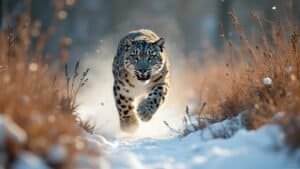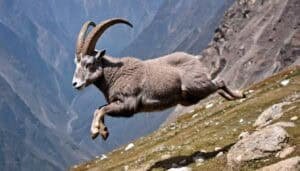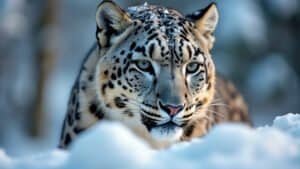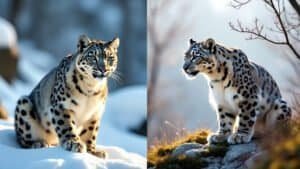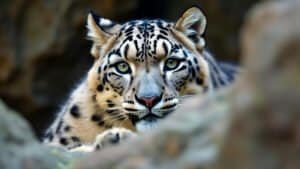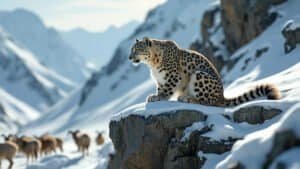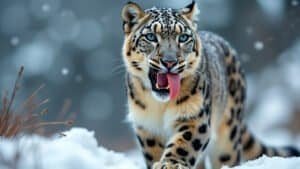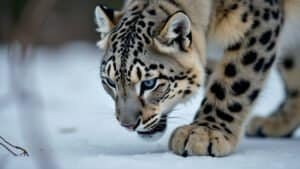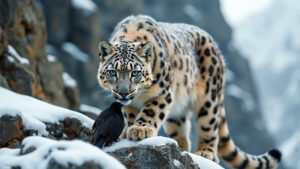Introduction
Snow leopards are known for their elusive nature and remarkable ability to thrive in harsh, mountainous terrains
One of the key factors influencing their survival is their seasonal movements, which directly impact their diet. These majestic predators traverse different altitudes throughout the year, leading to significant changes in prey availability and hunting strategies
This article delves into the intricacies of snow leopards’ seasonal movements, examining how these shifts affect their diet, from the high-altitude prey of winter to the low-altitude alternatives of summer, and how these changes are being further influenced by climate change
Snow Leopards’ Seasonal Movements: An Overview
Snow leopards, Panthera uncia, inhabit some of the most rugged and remote terrains on Earth, primarily found across the mountain ranges of Central and South Asia, including the Himalayas, the Tibetan Plateau, and the Altai Mountains
These regions experience extreme seasonal variations in temperature, snow cover, and vegetation, which directly influence the movements and behavior of snow leopards
As apex predators, their survival hinges not only on their adaptability to these harsh environments but also on their ability to follow prey across different altitudes throughout the year
Typical Habitats Across Seasons
Snow leopards are highly specialized in navigating steep, rocky terrains, where their thick fur, large paws, and powerful limbs provide advantages in the cold and rugged landscapes
During the winter months, snow leopards typically reside at lower altitudes ranging from 8,000 to 12,000 feet (2,400 to 3,700 meters) above sea level. At these elevations, the snow is less deep, and prey such as blue sheep (Pseudois nayaur) and ibex (Capra sibirica) are more concentrated, providing an essential food source during this period when resources are scarce
In contrast, during the summer months, as snow melts and vegetation becomes more abundant at higher altitudes, snow leopards move upward to elevations between 12,000 and 18,000 feet (3,700 to 5,500 meters). This seasonal migration allows them to access prey that shifts to these higher regions, such as marmots (Marmota spp.), Himalayan tahr (Hemitragus jemlahicus), and young ibex that now graze on the rich summer pastures
These altitudinal shifts are critical for maintaining the energy balance and reproductive health of snow leopards, as the availability of prey directly influences their ability to survive and raise offspring
Reasons Behind Seasonal Movements
The primary driver of snow leopards’ seasonal movements is the availability of prey
Prey animals such as blue sheep and ibex exhibit altitudinal migrations in response to the changing seasons, moving to lower elevations in winter to avoid deep snow and access forage, and returning to higher elevations in summer when food is more plentiful. Snow leopards, being obligate carnivores, must follow these prey migrations to ensure a steady food supply throughout the year
Moreover, snow cover and temperature play significant roles in these movements. Snow leopards are well adapted to cold environments, but deep snow can limit their ability to hunt effectively. Therefore, they tend to avoid areas with excessive snow depth, preferring regions where the snow is shallow enough to allow for efficient stalking and ambushing of prey
During the summer, the retreat of snowlines opens up new habitats at higher elevations, where snow leopards can hunt with less competition from other predators and take advantage of the increased prey density
Impacts on Behavior and Physiology
The seasonal movements of snow leopards are not just about following prey; they also have profound impacts on their behavior and physiology. For instance, these movements influence their territoriality
During the winter, when prey is concentrated in lower altitudes, snow leopards may exhibit smaller home ranges and increased territorial overlap as multiple individuals target the same prey-rich areas. In contrast, during the summer, their territories expand as they disperse across the broader, prey-dense higher elevations
Physiologically, the seasonal shifts in diet resulting from these movements necessitate adaptations in metabolism. Winter prey, such as blue sheep, tends to be leaner due to the scarcity of food, meaning snow leopards must consume more to meet their energy needs
Conversely, summer prey, including young ibex and marmots, are often more abundant and nutritious, allowing snow leopards to store fat and build up energy reserves for the harsher winter months ahead
Understanding these seasonal patterns is crucial for conservation efforts, as it helps in identifying critical habitats that need protection throughout the year. With climate change altering the dynamics of snow cover, prey availability, and vegetation, these movements and their effects on snow leopards’ diets are becoming increasingly unpredictable, posing new challenges for the species’ survival
How Seasonal Movements Affect Prey Availability
The seasonal movements of snow leopards are closely tied to the availability and distribution of their prey. As these big cats traverse various altitudes throughout the year, the types of prey they hunt change accordingly, impacting their overall diet and hunting strategies
Understanding how prey availability shifts with the seasons is crucial for grasping the challenges snow leopards face in maintaining their energy requirements and supporting their offspring
Winter Prey: High-Altitude Choices
During the winter, snow leopards descend to lower altitudes where prey is more accessible. This is primarily because deep snow in higher elevations makes it difficult for both the snow leopards and their prey to move and forage
The most common winter prey in these lower altitudes includes blue sheep (Pseudois nayaur) and ibex (Capra sibirica). These ungulates are well adapted to the cold but, like snow leopards, they migrate to avoid areas with the deepest snow
Blue sheep, also known as bharal, are particularly significant to the winter diet of snow leopards. These sheep are found at elevations between 9,800 and 13,000 feet (3,000 to 4,000 meters) during winter, grazing on the sparse vegetation that emerges from under the snow
Despite the reduced nutritional value of winter vegetation, blue sheep are resilient, and their predictable presence at lower altitudes makes them a reliable food source for snow leopards. Studies have shown that blue sheep can constitute up to 50% of a snow leopard’s diet during the winter months
Ibex, another crucial prey species, also migrate to lower elevations during the winter, although they typically stay slightly higher than blue sheep, occupying altitudes around 10,000 to 14,000 feet (3,050 to 4,250 meters)
Ibex are agile climbers and prefer rocky terrains, which provide both food and protection from predators. However, snow leopards, with their remarkable climbing ability, can effectively hunt ibex, despite the challenging terrain. The availability of ibex is vital, especially in regions where blue sheep populations are lower or less accessible
Summer Prey: Low-Altitude Alternatives
As temperatures rise and snow melts, snow leopards migrate to higher altitudes, following the upward movement of their prey
During the summer, prey diversity increases, offering snow leopards a broader range of hunting opportunities. Marmots (Marmota spp.) become a significant part of the snow leopard’s diet in these months. Marmots are burrowing rodents that are found at elevations between 12,000 and 16,000 feet (3,700 to 4,900 meters) during the summer
These rodents are not only abundant but also rich in fat, providing a high-energy food source during a period when snow leopards need to replenish their reserves
Himalayan tahr (Hemitragus jemlahicus), another prey species, also moves to higher elevations in summer. These large ungulates occupy steep, rocky slopes at altitudes up to 18,000 feet (5,500 meters), where they graze on the lush alpine vegetation
Snow leopards target both adult tahr and their young, with the latter being easier to hunt. The presence of tahr in snow leopard habitats is crucial during the summer because it allows the big cats to build up the necessary fat reserves for the upcoming winter months
In addition to marmots and tahr, snow leopards may also prey on the young of ibex and blue sheep, which remain at higher altitudes during the summer. These young animals are more vulnerable than adults, making them easier prey, which helps snow leopards maintain their energy levels with less effort
Variability in Prey Abundance
Prey availability for snow leopards is not only influenced by altitude and season but also by other factors such as competition, human activity, and climate change
Competition from other predators like wolves and bears can affect the abundance of prey available to snow leopards, particularly during the critical winter months when food is scarce
Human activities, including livestock grazing and habitat fragmentation, can also impact the populations of wild prey species, sometimes forcing snow leopards to prey on domestic livestock, which can lead to conflict with local communities
Climate change is increasingly affecting prey availability as well. Changes in snowfall patterns, temperature fluctuations, and shifting vegetation zones are altering the migratory patterns of prey species, sometimes leading to mismatches in the timing of snow leopard movements and prey availability
For instance, if snow melts earlier in the year, prey species might move to higher altitudes sooner than expected, forcing snow leopards to either follow them earlier or risk a period of food scarcity
Understanding these dynamics is essential for conservation efforts. Protecting both the snow leopards and their prey across these seasonal landscapes requires an integrated approach that considers the impacts of climate change, human activity, and interspecies competition on the delicate balance of these ecosystems
Adaptations to Seasonal Diet Changes
Snow leopards have evolved a variety of adaptations to cope with the seasonal changes in their diet, which are influenced by the availability and type of prey in their environment
These adaptations range from their hunting strategies to physiological changes that enable them to survive in the extreme conditions of their mountainous habitats. Understanding these adaptations is crucial for appreciating how snow leopards manage to thrive in such a challenging environment
Hunting Strategies Across Seasons
Snow leopards are solitary hunters, and their hunting strategies vary significantly depending on the season and the type of prey they are targeting
During the winter months, when prey is scarce and often concentrated in smaller areas, snow leopards rely on ambush tactics. Their natural camouflage, with fur patterned to blend into rocky and snowy landscapes, allows them to get close to prey without being detected
In these conditions, they often target larger prey such as blue sheep and ibex, which require a precise and powerful attack to bring down
In contrast, during the summer, when prey is more abundant and varied, snow leopards can afford to be more opportunistic. They may hunt smaller animals like marmots or the young of larger species, which are easier to catch but require more frequent hunting to meet their nutritional needs
The increased prey density and variety in summer also allow snow leopards to be more active, with hunting success rates typically higher than in winter. The seasonal abundance of prey like marmots, which are rich in fat, is particularly important as it helps snow leopards build up the energy reserves they will need for the leaner winter months
Nutritional Adaptations to Different Prey
The snow leopard’s diet changes considerably with the seasons, requiring them to adapt their nutritional intake accordingly
In winter, when the primary prey consists of leaner animals like blue sheep and ibex, snow leopards must consume larger quantities to meet their energy needs. The low-fat content of winter prey means that snow leopards must expend more energy hunting, as each kill provides fewer calories
During the summer, however, the situation changes. Prey like marmots and young ungulates are not only more abundant but also richer in fat, providing a higher caloric intake per meal. This seasonal shift in diet allows snow leopards to accumulate fat reserves that are critical for their survival during the winter, when hunting becomes more challenging and energy requirements are higher
The ability to switch between different types of prey and adjust their hunting strategies accordingly is a key adaptation that enables snow leopards to maintain their energy balance throughout the year
Moreover, the composition of their diet can affect their reproductive success. Studies have shown that female snow leopards with access to high-calorie prey during the summer are more likely to successfully raise cubs, as they can produce more milk and provide better care for their offspring
This underscores the importance of summer prey in the overall life cycle of snow leopards and highlights how seasonal diet changes are linked to their reproductive strategies
Role of Vegetation and Habitat in Diet Shifts
Vegetation plays a crucial role in the seasonal diet shifts of snow leopards, albeit indirectly. The availability of vegetation affects the distribution and abundance of herbivorous prey species, which in turn influences the hunting patterns of snow leopards
In the winter, as vegetation becomes scarce at higher altitudes, herbivores like blue sheep and ibex move to lower elevations where they can find food, and snow leopards follow
During the summer, the melting snow and warmer temperatures lead to a resurgence of vegetation at higher altitudes, which attracts herbivores to these areas. Snow leopards, in turn, migrate to these higher altitudes to exploit the newly available prey
This seasonal movement is not just about following the prey but also about positioning themselves in habitats that offer the best hunting opportunities. Rocky outcrops, steep cliffs, and alpine meadows provide the ideal environment for snow leopards to stalk and ambush their prey, and the availability of such habitats is closely linked to the seasonal growth of vegetation
Furthermore, vegetation affects the visibility and cover available to snow leopards. In the summer, dense vegetation can provide additional cover, making it easier for snow leopards to approach their prey unnoticed. However, this also means that prey animals can hide more effectively, sometimes making hunting more challenging despite the abundance of food
Conversely, in the winter, when vegetation is sparse, snow leopards rely more on their camouflage against the snowy and rocky backdrop to remain concealed while hunting
The interplay between vegetation, prey availability, and habitat structure highlights the complexity of the snow leopard’s seasonal adaptations. These adaptations not only allow them to survive but also to thrive in some of the most inhospitable environments on Earth
Impact of Climate Change on Movements and Diet
Climate change is increasingly influencing the habitats and behaviors of many species worldwide, and snow leopards are no exception
As global temperatures rise and weather patterns become more unpredictable, the delicate balance of snow leopards’ seasonal movements and diet is being disrupted. These changes have far-reaching implications not only for snow leopards but also for the entire ecosystems they inhabit
Changing Patterns of Snowfall and Temperature
One of the most direct effects of climate change on snow leopards is the alteration of snowfall patterns. Snow leopards rely on specific snow conditions to hunt effectively and to access their prey
Traditionally, snow leopards move to lower altitudes in winter to avoid deep snow and follow their prey, which also migrates downward. However, with warmer winters and reduced snowfall, the dynamics of these migrations are changing
In some areas, reduced snowfall has led to prey species remaining at higher altitudes throughout the winter, which forces snow leopards to adjust their movements accordingly. This shift can increase the energy expenditure of snow leopards, as they must traverse more difficult terrain and endure harsher conditions to hunt
Additionally, the lack of snow cover can reduce the snow leopard’s natural camouflage, making it harder for them to ambush prey and increasing the likelihood of failed hunts
Conversely, in regions where snowfall has become more erratic or where snowmelt occurs earlier in the year, snow leopards may find themselves in situations where prey is less concentrated and more dispersed, making it more challenging to find food
Early snowmelt also affects the availability of water sources, which are crucial for both prey and predators during the summer months
Effects on Prey Distribution
Climate change is also altering the distribution of prey species, which in turn impacts the diet of snow leopards. As temperatures rise, the vegetation zones that support prey species like blue sheep and ibex are shifting upward
This means that these prey species may no longer be found at the same altitudes where snow leopards typically hunt, forcing the predators to either move higher or face food shortages
Moreover, the timing of prey migrations may become increasingly unpredictable. For instance, if plants begin to grow earlier due to warmer temperatures, herbivores might migrate earlier in the year, potentially leading to a mismatch between when snow leopards arrive in an area and when their prey is most abundant
Such mismatches can reduce the hunting success of snow leopards, leading to nutritional stress, particularly during the critical periods of breeding and cub-rearing
In addition, the overall health and population sizes of prey species may decline due to the combined effects of habitat loss, reduced food availability, and increased competition from other herbivores or livestock
A decline in prey populations would have a direct negative impact on snow leopards, which could face increased competition for food and higher mortality rates as a result
Long-Term Implications for Snow Leopard Conservation
The long-term implications of climate change on snow leopards are profound and multifaceted. As their habitats shift and prey becomes less predictable, snow leopards may be forced to expand their ranges, potentially leading to more frequent encounters with humans and livestock
This could increase the likelihood of human-wildlife conflict, as snow leopards may prey on livestock when wild prey is scarce, leading to retaliation from local communities
Conservation strategies must therefore adapt to these new challenges. Protecting critical habitats at various altitudes is essential to ensure that snow leopards have access to the resources they need throughout the year
This includes safeguarding migration corridors that allow snow leopards to move freely between their summer and winter ranges without encountering human-made barriers
Additionally, efforts to mitigate climate change, such as reducing greenhouse gas emissions and preserving carbon-rich ecosystems like forests, are vital for the long-term survival of snow leopards and their prey. Research and monitoring programs that track changes in snow leopard behavior, prey populations, and habitat conditions will be crucial in developing effective conservation strategies that can adapt to the rapidly changing environment
Finally, engaging local communities in conservation efforts is essential. By promoting coexistence and providing alternative livelihoods that reduce dependence on livestock, conservationists can help to reduce the potential for conflict and create a more sustainable future for both snow leopards and the people who share their environment
Conclusion
The seasonal movements of snow leopards play a critical role in shaping their diet, survival strategies, and overall health. As these elusive predators navigate the harsh and varied terrains of Central and South Asia, they follow prey across different altitudes, adapting their hunting strategies and nutritional intake according to the changing seasons
In winter, snow leopards descend to lower elevations to hunt blue sheep and ibex, while in summer, they ascend to higher altitudes to take advantage of the more abundant prey such as marmots and young ungulates. These seasonal migrations are not just about following food; they also involve complex adaptations in behavior and physiology, enabling snow leopards to survive in some of the most challenging environments on Earth
However, climate change is increasingly disrupting these patterns. Changes in snowfall, temperature, and vegetation are altering prey availability and distribution, forcing snow leopards to adjust their movements and hunting strategies. This creates new challenges for their survival and highlights the urgent need for adaptive conservation strategies that can respond to the impacts of a changing climate
Protecting critical habitats, ensuring the availability of prey, and engaging local communities in conservation efforts are essential steps in securing a future for snow leopards. As these majestic creatures continue to roam the mountains, understanding and mitigating the effects of climate change on their seasonal movements and diet will be key to their conservation


